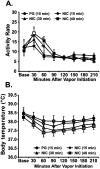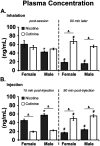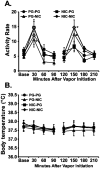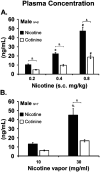This is a preprint.
Hyperactivity Induced By Vapor Inhalation of Nicotine in Male and Female Rats
- PMID: 38405720
- PMCID: PMC10888868
- DOI: 10.1101/2024.02.12.579996
Hyperactivity Induced By Vapor Inhalation of Nicotine in Male and Female Rats
Abstract
Rationale: Preclinical models of electronic nicotine delivery system (ENDS; "e-cigarette") use have been rare, so there is an urgent need to develop experimental approaches to evaluate their effects.
Objective: To contrast the impact of inhaled nicotine across sex.
Methods: Male and female Wistar rats were exposed to vapor from a propylene glycol vehicle (PG), nicotine (NIC; 1-30 mg/mL in PG), or were injected with NIC (0.1-0.8 mg/kg, s.c.), and then assessed for changes in temperature and activity. The antagonist mecamylamine (2 mg/kg) was administered prior to NIC to verify pharmacological specificity. Plasma levels of nicotine and cotinine were determined after inhalation and injection.
Results: Activity increased in females for ~60 minutes after nicotine inhalation, and this was blocked by mecamylamine. A similar magnitude of hyperlocomotion was observed after s.c. administration. Body temperature was reduced after nicotine inhalation by female rats but mecamylamine increased this hypothermia. Increased locomotor activity was observed in male rats if inhalation was extended to 40 minutes or when multiple inhalation epochs were used per session. The temperature of male rats was not altered by nicotine. Plasma nicotine concentrations were slightly lower in male rats than in female rats after 30-minute nicotine vapor inhalation and slightly higher after nicotine injection (1.0 mg/kg, s.c.).
Conclusions: Nicotine inhalation increases locomotor activity in male and female rats to a similar or greater extent than by subcutaneous injection. Sex differences were observed, which may be related to lower nicotine plasma levels, lower baseline activity and/or a higher vehicle response in males.
Conflict of interest statement
Declaration of Interests: The authors declare no financial conflicts which affected the conduct of this work.
Figures










Similar articles
-
Effects of nicotine and THC vapor inhalation administered by an electronic nicotine delivery system (ENDS) in male rats.Drug Alcohol Depend. 2019 May 1;198:54-62. doi: 10.1016/j.drugalcdep.2019.01.027. Epub 2019 Feb 27. Drug Alcohol Depend. 2019. PMID: 30878767 Free PMC article.
-
Adult Consequences of Repeated Nicotine Vapor Inhalation in Adolescent Rats.Nicotine Tob Res. 2024 May 22;26(6):715-723. doi: 10.1093/ntr/ntad211. Nicotine Tob Res. 2024. PMID: 37946372 Free PMC article.
-
Vapor inhalation of cannabidiol (CBD) in rats.Pharmacol Biochem Behav. 2019 Sep;184:172741. doi: 10.1016/j.pbb.2019.172741. Epub 2019 Jul 20. Pharmacol Biochem Behav. 2019. PMID: 31336109 Free PMC article.
-
Effects of Δ9-THC and cannabidiol vapor inhalation in male and female rats.Psychopharmacology (Berl). 2018 Sep;235(9):2541-2557. doi: 10.1007/s00213-018-4946-0. Epub 2018 Jun 16. Psychopharmacology (Berl). 2018. PMID: 29907926 Free PMC article.
-
Nicotine e-cigarette vapor inhalation effects on nicotine & cotinine plasma levels and somatic withdrawal signs in adult male Wistar rats.Psychopharmacology (Berl). 2020 Mar;237(3):613-625. doi: 10.1007/s00213-019-05400-2. Epub 2019 Nov 23. Psychopharmacology (Berl). 2020. PMID: 31760460 Free PMC article.
References
-
- Diehl KH, Hull R, Morton D, Pfister R, Rabemampianina Y, Smith D, Vidal JM, van de Vorstenbosch C (2001) A good practice guide to the administration of substances and removal of blood, including routes and volumes. J Appl Toxicol 21: 15–23. - PubMed
-
- Donny EC, Caggiula AR, Rowell PP, Gharib MA, Maldovan V, Booth S, Mielke MM, Hoffman A, McCallum S (2000) Nicotine self-administration in rats: estrous cycle effects, sex differences and nicotinic receptor binding. Psychopharmacology 151: 392–405. - PubMed
Publication types
Grants and funding
LinkOut - more resources
Full Text Sources
